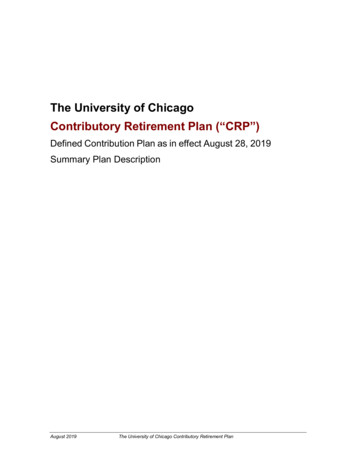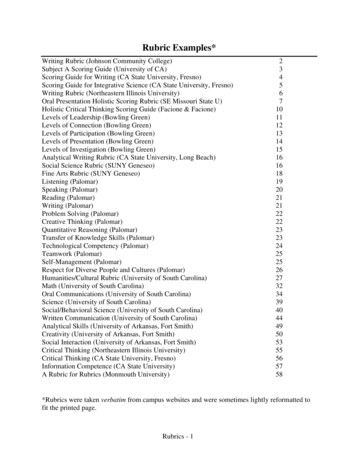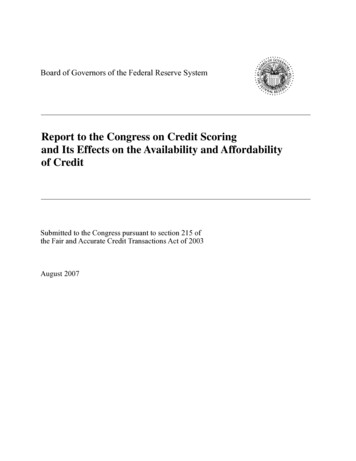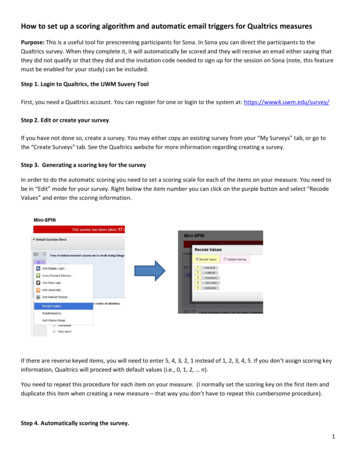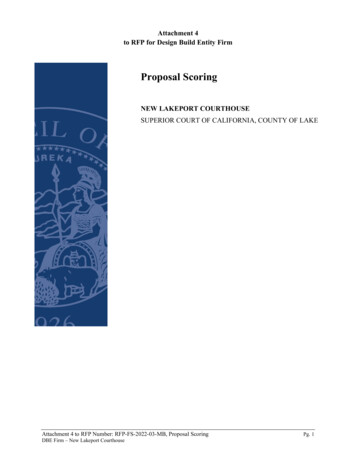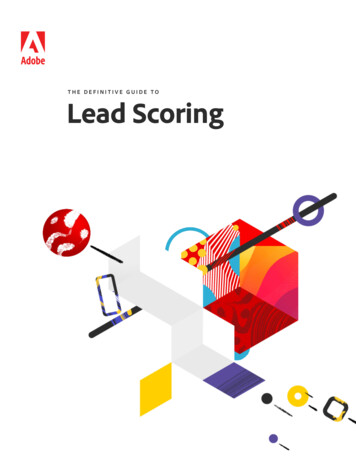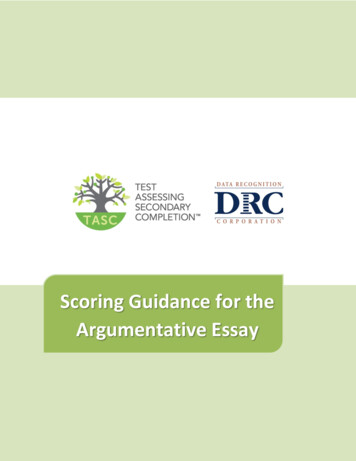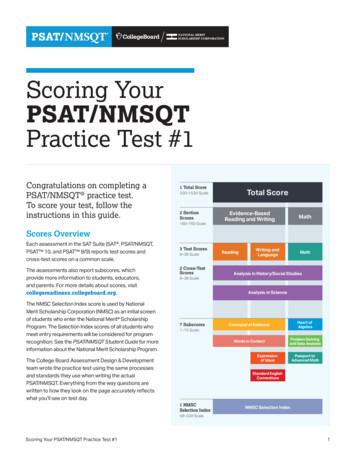
Transcription
Research ReportETS RR–17-14Implementing a Contributory ScoringApproach for the GRE Analytical WritingSection: A Comprehensive EmpiricalInvestigationF. Jay BreyerAndré A. RuppBrent BridgemanApril 2017
ETS Research Report SeriesEIGNOR EXECUTIVE EDITORJames CarlsonPrincipal PsychometricianASSOCIATE EDITORSBeata Beigman KlebanovSenior Research ScientistJohn MazzeoDistinguished Presidential AppointeeHeather BuzickResearch ScientistDonald PowersManaging Principal Research ScientistBrent BridgemanDistinguished Presidential AppointeeGautam PuhanPrincipal PsychometricianKeelan EvaniniResearch DirectorJohn SabatiniManaging Principal Research ScientistMarna Golub-SmithPrincipal PsychometricianElizabeth StoneResearch ScientistShelby HabermanDistinguished Presidential AppointeeRebecca ZwickDistinguished Presidential AppointeeAnastassia LoukinaResearch ScientistPRODUCTION EDITORSKim FryerManager, Editing ServicesAyleen GontzSenior EditorSince its 1947 founding, ETS has conducted and disseminated scientific research to support its products and services, andto advance the measurement and education fields. In keeping with these goals, ETS is committed to making its researchfreely available to the professional community and to the general public. Published accounts of ETS research, includingpapers in the ETS Research Report series, undergo a formal peer-review process by ETS staff to ensure that they meetestablished scientific and professional standards. All such ETS-conducted peer reviews are in addition to any reviews thatoutside organizations may provide as part of their own publication processes. Peer review notwithstanding, the positionsexpressed in the ETS Research Report series and other published accounts of ETS research are those of the authors andnot necessarily those of the Officers and Trustees of Educational Testing Service.The Daniel Eignor Editorship is named in honor of Dr. Daniel R. Eignor, who from 2001 until 2011 served the Research andDevelopment division as Editor for the ETS Research Report series. The Eignor Editorship has been created to recognizethe pivotal leadership role that Dr. Eignor played in the research publication process at ETS.
ETS Research Report Series ISSN 2330-8516RESEARCH REPORTImplementing a Contributory Scoring Approach for theGRE Analytical Writing Section: A Comprehensive EmpiricalInvestigationF. Jay Breyer, André A. Rupp, & Brent BridgemanEducational Testing Service, Princeton, NJIn this research report, we present an empirical argument for the use of a contributory scoring approach for the 2-essay writing assessment of the analytical writing section of the GRE test in which human and machine scores are combined for score creation at the taskand section levels. The approach was designed to replace a currently operational all-human check scoring approach in which machinescores are used solely as quality-control checks to determine when additional human ratings are needed due to unacceptably large scorediscrepancies. We use data from 6 samples of essays collected from test takers during operational administrations and special validitystudies to empirically evaluate 6 different score computation methods. During the presentation of our work, we critically discuss keymethodological design decisions and underlying rationales for these decisions. We close the report by discussing how the researchmethodology is generalizable to other testing programs and use contexts. Keywords Automated essay scoring; check scoring approach; contributory scoring approach; GRE ; GRE analytical writing;writing assessment; design decisions for automated scoring deployment; scoring methodologydoi:10.1002/ets2.12142Automated essay scoring is a term that describes various artificial intelligence scoring technologies for extended writingtasks and is employed in many large-scale testing programs; see Shermis and Hamner (2013) for a comparison of differentapplications. Under an automated essay scoring approach, through use of specialized software, digitally submitted essaysget automatically parsed and specific linguistic elements pertaining to aspects of grammar, syntax, vocabulary, and organization, among others, get evaluated and used in prediction models to create holistic scores or diagnostic feedback. Inany consideration of using automated essay scoring—specifically for operational assessments that aid in making highstakes decisions—one needs to ensure that various stringent quality-control mechanisms are in place and that evidencefor different facets of the core validity argument is collected (for more details, see, e.g., Bejar, Mislevy, & Zhang, 2016;Williamson, Xi, & Breyer, 2012).These fundamental issues take on a particular importance when the scoring approach for an assessment is changed,such as when one considers moving from a so-called all-human check scoring approach to a so-called contributory scoringapproach, which is the context that is the focus of the studies in this report. In the former, machine scores are only usedfor identifying cases when additional human raters might be needed to resolve discrepancies between first human ratingsand machine scores; however, machine scores are not used for eventual reporting. In the latter approach, machine scoresare generally combined with human ratings for reporting to save the costs of additional human raters.In this research report, we specifically present an empirical argument for the use of a contributory scoring approachin place of an all-human check scoring approach for the GRE Analytical Writing (GRE-AW) section. We argue thatthe contributory scoring approach yields more reliable and valid scores, which is especially critical for assessments withhigh-stakes consequences such as the GRE. We describe a systematic process that involves several data samples, analyses,and associated methodological design decisions to provide the necessary empirical evidence to deploy the contributoryscoring approach in practice.We have organized this report into five major sections. In the first section, we discuss key terminology and methodological approaches for automated scoring to create a framework for the discussion of the methods and results later in thereport. In the second section, we describe the motivation for this research along with the research questions that we use Corresponding author: A. A. Rupp, E-mail: arupp@ets.orgETS Research Report No. RR-17-14. 2017 Educational Testing Service1
F. J. Breyer et al.Implementing a Contributory Scoring Approach for GRE-AWto structure our investigations. In the third section, we describe the samples and methodological approaches that we usedto answer our research questions. In the fourth section, we describe the results of our analyses. We close the report with abrief summary of key findings and with a discussion of limitations of this work and recommendations for best practices.Terminology and MotivationThe GRE and the GRE Analytical Writing SectionThe GRE revised General Test comprises three sections: (a) verbal reasoning, (b) quantitative reasoning, and (c) analytical writing. In our work, we use scale scores from all three sections for correlational analyses to empirically evaluaterelationships between verbal, quantitative, and writing skills.Specifically, the verbal reasoning section measures skills that involve analyzing, evaluating, and synthesizing information contained in written material while recognizing relationships among different concepts. The quantitative reasoningsection measures problem-solving ability that relies on arithmetic, algebra, geometry, and numeric skills. The GRE-AWsection is designed specifically to assess critical thinking and analytic writing skills that provide evidence of writing toexpress and support complex ideas clearly and effectively (Educational Testing Service [ETS], 2016). All of the skills setsin the three test sections have been shown to be necessary for graduate and business school success (Kuncel, Hezlett, &Ones, 2014; Young, Klieger, Bochenek, Li, & Cline, 2014).The GRE-AW section consists of two essays; each essay is produced under a 30-minute time limit and typed on a wordprocessor with limited capabilities (e.g., a cut-and-paste function is available but spelling error detection and grammarchecking functions are not). The first task asks test takers to evaluate or critique an argument presented in the promptby developing supporting evidence and reasoning; this task is consequently called the argument task. The second taskrequires the test taker to develop and support a position on an issue provided in the prompt; this task is consequentlycalled the issue task.Automated Scoring Model TypesFor the kinds of automated scoring models we consider in this report, we say that an automated/machine score is producedby an automated/machine scoring model using a supervised learning approach. The automated scoring model is built byextracting linguistic features from the response text through use of natural language processing techniques (Manning &Schütze, 1999) and utilizes these features to predict holistic human ratings. For the purpose of this report, we specificallyuse a nonnegative linear least squares regression approach (Cohen, Cohen, West, & Aiken, 2003); we do not consider othermachine learning techniques (Alpaydin, 2014) and other prediction models. It is often helpful to distinguish cases inwhich models are built for individual prompts or for prompt families that share the same core design parameters (i.e.,task types). Models for the former are sometimes referred to as prompt-specific models, whereas models for the latter aresometimes referred to as generic models. In this report, we specifically use two generic models associated with the twodistinct GRE-AW tasks under consideration.Scoring Approaches for ReportingAs mentioned earlier, when considering the use of automated scoring in operational practice, it can be helpful to differentiate between check and contributory scoring approaches as well as, in certain lower stakes use contexts, sole machinescoring approaches; for a broader range of scoring approaches, please see Foltz, Leacock, Rupp, and Zhang (2016). Wedescribe each of these three approaches briefly in turn as they had been implemented in the past, in the case of the checkscoring approach, or are currently implemented, in the case of the contributory scoring approach, within the GRE-AWsection. The descriptions of these three approaches should be seen as illustrative and not comprehensive, as modificationsand adaptations are likely in place in other testing contexts.Under either a check or a contributory scoring approach, the first human rating is compared to the machine score, andtheir relative difference is evaluated using what we call a primary adjudication threshold. Under a check scoring approach,the first human rating then becomes the task score if the score difference is below the primary adjudication threshold.If the score difference is equal to or greater than the threshold, a second human rater is asked to provide another rating.2ETS Research Report No. RR-17-14. 2017 Educational Testing Service
F. J. Breyer et al.Implementing a Contributory Scoring Approach for GRE-AWThis rating is then combined with the first human rating for operational reporting or, in a few rare instances, adjudicatedthrough a supervisor rating; in either case, only human scores are reported.Under a contributory scoring approach, if the human–machine score difference is below the primary adjudicationthreshold, then the first human rating is combined in a weighted manner—for example, a simple average—with themachine score; we call this the primary score combination rule. If the human–machine score difference is equal to orlarger than the primary adjudication threshold, then, as in the check scoring approach, additional human ratings areemployed, which are subsequently combined with human and/or machine scores unless a direct adjudication through asupervisor is required.Under either scoring approach, how score combinations are made once the need for an adjudication is identified is afunction of what we call the secondary adjudication threshold and the associated secondary score combination rules thatspecify secondary allowable score differences and the mechanism for combining sets of scores, respectively. Together,the primary adjudication threshold, the primary score combination rule, the secondary adjudication threshold, and thesecondary score combination rules form a task-level score computation method. Once the task scores are available, theyneed to be further combined into a reported total score, which requires the determination of task score weights in whatwe call a task score combination rule. This total score might then be scaled using a reference distribution for operationalreporting.Under a sole machine scoring approach, as the name implies, the machine score is used by itself for operational scoringwithout any additional human ratings. In high-stakes applications with important consequences for individual test takersand rigorous fairness standards for population subgroups, the lack of a human rating may not be acceptable. The sensitivityof validation issues in such a use context has been underscored in the popular press in recent years, where certain authorshave criticized the sole use of machine scores in certain situations that were particularly susceptible to gaming the system(Perelman, 2014a, 2014b; Winerip, 2012).The argument of critics is that “nonsense” and perhaps “obviously flawed” essays that result from gaming attemptscan be detected by human readers but not always by built-in machine detectors (i.e., advisories) in the automated scoringsystem (see Ramineni, Trapani, Williamson, Davey, & Bridgeman, 2012a, or Breyer et al., 2014, for a description of the different advisories evaluated for the GRE-AW section). For the purpose of this report, the sole machine scoring approach isnot considered further for the GRE-AW section because the consequential use of the GRE-AW section scores is associatedwith relatively high stakes for individual test takers.Levels of ScoringIn describing the empirical evaluations of the check and contributory scoring approaches in the context of the GRE-AWsection in more detail, it is important to consider three levels of scoring that occur:1.2.3.the human and/or machine ratings (rating level),the task scores for which the human or human and machine ratings are combined in some fashion after adjudicationprocedures are instantiated (task level), andthe aggregated total score for which the individual task scores are combined (section score level).We will use different score levels for different analyses with the strongest emphasis on task scores and the aggregateGRE-AW section score.Five Methodological Design DecisionsAs described in the previous section, when implementing a contributory scoring approach operationally, testing programsneed to make five important methodological design decisions at the different score levels based on empirical evidence;these decisions involve determining1.2.3.4.5.the primary score combination rule,the primary adjudication threshold,the secondary adjudication threshold,the secondary score combination rules, andthe task score combination rule.ETS Research Report No. RR-17-14. 2017 Educational Testing Service3
F. J. Breyer et al.Implementing a Contributory Scoring Approach for GRE-AWNote that, in the context of the GRE-AW section, design decisions for 1–4 affect the computation of the issue andargument task scores, while design decisions for 5 are about the creation of the GRE-AW section score. We refer to thereported GRE-AW section score simply as the “AW score” in the remainder of this report for brevity and to distinguish itlinguistically from supplementary writing scores that we obtained from independent performance measures for some ofour test-taker samples.Determining the Primary Adjudication ThresholdA major consideration for determining the primary adjudication threshold through empirical evidence has been theobservation that human and machine scores can separate from each other for some—but not all—subgroups of testtakers that are pertinent in comprehensive fairness evaluations; we call this issue score separation in short (Breyer et al.,2014; Bridgeman, Trapani, & Attali, 2012). Score separation is not something that can be evaluated properly by focusingon human–machine score differences at the rating level but, rather, needs to be evaluated by focusing on these differences at the task or reported scale score level once adjudication procedures have been applied. Furthermore, it is generallyadvisable to perform these evaluations with different score pairs or frames of reference. In our work, we compared a contributory task score to a “gold standard” double-human score (i.e., where every response receives two human ratings) andto a (previously operational) check score.For different assessments at ETS, the primary adjudication threshold has been set at .5 for the GRE-AW issue andargument tasks under an all-human check scoring approach as well as at 1.0 for the TOEFL test’s integrated task undera contributory scoring approach when automated scoring was first implemented. This was done because of the relativelylarge observed score separation for subgroups at the rating level at the time in order to bring in additional human raterseven for somewhat smaller score differences. In contrast, the primary adjudication threshold has been set at 1.5 for both theTOEFL independent task and the PRAXIS test’s argumentative task under a contributory scoring approach. Similarly, itwas recently reset to 2.0 for the TOEFL integrated task, with the potentially undesirable effects of the larger primary threshold on score separation compensated for by giving human ratings twice the weight of the machine scores for reportingpurposes (Breyer et al., 2014; Ramineni, Trapani, & Williamson, 2015; Ramineni, Trapani, Williamson, Davey, & Bridgeman, 2012b; Ramineni et al., 2012a).In the work presented in this report, we report on findings for primary adjudication thresholds of .5, .75, and 1.0 becausethese were considered acceptable a priori by the program. Reasons for this choice include efforts to reduce the possibilityof threats to validity due to some vulnerabilities of any automated system to aforementioned gaming approaches andassociated sensitivities by stakeholders regarding the use of automated scoring systems in general; however, informationfrom additional analyses for thresholds of 1.5 and 2.0 are available upon request from the second author. Determining the Primary Score Combination RuleThis methodological step is about determining the weights that the human ratings and, possibly, machine scores receiveunder a particular scoring approach. Common past practice at ETS has been to equally weight any ratings when creatingtask scores (Breyer et al., 2014; Ramineni et al., 2012b). However, as noted, there are exceptions. For example, for theintegrated task on the TOEFL test, which is already scored using a contributory scoring approach, the first human ratingreceives twice the weight of the machine score to partially compensate for the fact that differences between aspects of theconstruct that human raters can attend to and the machine can attend to are larger for this kind of task.More generally speaking, instead of simply defaulting to an equally weighted average, we argue that this weightingdecision should be made through the use of empirical regression procedures. The methodology used to arrive at thisdecision might involve a design in which the human and machine ratings serve as the predictors and an independentcriterion, such as a double-human score, functions as the dependent variable. Determining this weighting scheme firstmakes most sense because the weighted ratings are used to form the task scores. For the check scoring approach, thereis no need to determine the weights of the ratings first because the automated scores do not figure into the calculation ofthe task scores and human ratings are treated as randomly equivalent (i.e., exchangeable), suggesting an equal weightingof any human ratings.In our work, we conceptually consider the human and machine scores as complementary, each measuring differentaspects of the writing construct (i.e., one might say that human raters use a holistic scoring process and automated systems4ETS Research Report No. RR-17-14. 2017 Educational Testing Service
F. J. Breyer et al.Implementing a Contributory Scoring Approach for GRE-AWuse an analytic scoring process). Thus we determined the appropriateness of the weights for the human and machineratings by predicting the score from an external measure of writing gathered in graduate school work and from an allhuman check score from the GRE-AW section obtained on an alternate occasion within a 6-month period.Determining the Secondary Adjudication ThresholdThe next methodological step is determining the secondary adjudication threshold, which determines the allowable scoredifference of the first human rating, possibly the machine score, and any additional human ratings that are brought in.For example, if a primary adjudication threshold under an all-human check scoring approach is .5 points, the secondarythreshold may be set to 1.5 or 2.0 points, depending on the testing program, the secondary score combination rules, andthe associated reporting stakes. In our work, we examined secondary adjudication thresholds of 1.001, 1.5, and 2.0, in linewith previous practice at ETS.Determining the Secondary Score Combination RulesThe next methodological step is determining the weights for how to combine human ratings and, possibly, machine scoresonce adjudication has become necessary. There are a variety of options, because multiple pairs of ratings can be comparedusing the secondary adjudication threshold once adjudication ratings are available. In particular, the selection of the secondary score combination rules and the secondary adjudication threshold is based on that combination of primary andsecondary adjudication thresholds and associated score combination rules that most minimizes a carefully selected targetcriterion. At ETS, the criterion that is most commonly chosen for high-stakes use contexts such as the GRE, TOEFL, andPRAXIS tests is the human–machine score difference for critical subgroups at the section score level. We refer to the jointset of threshold and score combination rules across all adjudication stages as the resulting score computation method. Inour work, we compared the performance of six different methods using standardized mean score differences for subgroupsas the primary evaluation criterion, along with a few secondary ones.Determining the Task Score Combination RuleFinally, a decision must be made on how to combine the individual task scores to create an aggregate section score that canthen be scaled to a reference distribution for reporting, if desirable. Note that the task score combination rule can have animpact on score validity when different tasks target rather distinct aspects of the overall writing construct. Consequently,different weighting schemes assign different degrees of relative importance to different aspects of the empirical constructrepresentation. Determining such weights empirically can be a useful activity for operational testing programs even if theempirical results are used as a reference point only and an equal weighting continues to be used, for example, for reasonsof consistency with past practice and ease of communicability.In the past at ETS, for the GRE-AW section, this weighting has taken the form of a simple average that is then roundedto half-point intervals, typically with an associated scale transformation. While this decision has been made by followingpast practices from other programs at ETS, we argue that it can be more strongly informed through the use of regressionprocedures in general. Under such a regression approach, the different individual task scores might form the predictors,and an independent criterion, such as a section score from an alternate testing occasion or a score from an independentwriting sample from graduate school course work, can form the dependent variable; this is the approach that we used inour work.Motivation and Research GoalsCheck Scoring Approach for the GRE Analytical Writing SectionIn the current implementation of the check scoring approach for the GRE-AW section, a first human rater evaluates eachessay, and, if the resulting score is from 1 to 6 inclusive (i.e., if the rater provides a nonzero rating), the essay response issent to the e-rater automated scoring engine, which then produces a score using a generic scoring model for that task; seeBurstein, Tetreault, and Madnani (2013) for an overview. If the first human rating is 0 or if e-rater produces an advisory,the essay is sent to a second human rater for verification. ETS Research Report No. RR-17-14. 2017 Educational Testing Service5
F. J. Breyer et al.Implementing a Contributory Scoring Approach for GRE-AWConceptually, a human rating of 0 indicates that writing skills cannot be reliably evaluated; for example, the responsedoes not correspond to the assigned topic, merely copies the assignment description, or is written in a foreign language.A machine advisory similarly indicates that the response should not be machine scored, albeit not always for the samereason that a human rater would give. For example, if the response is too short or too long relative to a calibration set,does not contain paragraph breaks, or contains atypical repetition, e-rater may produce an advisory, but a human ratermight consider these aspects acceptable for producing a reliable rating.When the unrounded machine score and the first human rating are within .5 points of each other (i.e., are belowthe primary adjudication threshold), the first human rating becomes the final task score; no other human raters evaluatethat essay. If an additional human rater is required to rate the essay, then the second human rating is compared to thefirst human rating using the secondary adjudication threshold. If those two human ratings are 1 point or less apart (i.e.,are considered “adjacent”), the final task score is the average of the two human ratings. The average, in this case, is theequal weighting of the two human ratings. If the two human ratings are more than 1 point apart (i.e., are not considered“adjacent”), then a third human is required and more complex secondary score combination rules specify how the humanratings are used in computing the final task score.As we noted in the first section, regardless of how many human ratings are required to arrive at a task score, the machinescore does not contribute to the task score under the all-human check scoring approach. Moreover, each argument andissue task is scored separately using the same process. To create the total AW section score, the resulting argument andissue task scores are combined and then averaged using equal weighting, and the resulting total score is then rounded upto the nearest half-point increment. This creates a reporting scale that ranges from a minimum score of 0 to a maximumscore of 6 in half-point increments (i.e., 0, .5, 1.5, 2, 2.5, , 5.5, 6); only the total score is reported for the GRE-AWsection (i.e., individual task scores are not reported).Previous Research on Scoring Approaches for the GRE Analytical Writing SectionTwo previous studies had supported the use of an all-human check scoring approach for the GRE-AW section. Ramineniet al. (2012a) found that a prompt-specific model was appropriate for argument prompts and that a generic model with aprompt-specific intercept was a viable candidate for use with issue prompts. Recently, Breyer et al. (2014) demonstratedthat two separate generic models, one for argument prompts and one for issue prompts, were appropriate for use in acheck score implementation as well.Both of these studies built and evaluated prompt-specific and generic models for argument and issue tasks separatelyand performed statistical evaluations by prompt, test center country, gender, and ethnic subgroups. The authors also evaluated correlations of task scores with scores from other GRE sections and simulated GRE-AW scores under each modelscenario and different primary adjudication thresholds. However, Ramineni et al. (2012a) and Breyer et al. (2014) did notcompare the all-human check scoring and contributory scoring approaches directly. They also focused their evaluationsextensively on reducing human–machine score separation for subgroups at the rating level rather than on reducing thisseparation at the section level. In the work that we present in this report, we fill in these gaps and subsequently argue forthe use of a contributory scoring approach using a broader portfolio of empirical evidence.Advantages of a Contributory Scoring ApproachThe present use of the all-human check scoring approach creates, in effect, two parallel scales for different subgroups oftest takers as a function of the discrete nature of the human score scale. Consider three examples presented in Table 1to illustrate this phenomenon. In each case, the test taker’s “true” score from two ideal human raters is 3.5; the resultingcheck and contributory scores are provided for the same machine (M) score, M 3.6; the primary adjudication thresholdis .5. The body of Table 1 shows the example number, the H1 and H2 ratings, and the task score results, along with anannotated score computation explanation.In example 1, an H1 rating of 3, an M rating of 3.6, and an H2 rating of 3 result in a task score of 3 under the all-humancheck and contributory scoring approaches because the absolute difference between H1 and M is larger than
Approach for the GRE Analytical Writing Section: A Comprehensive Empirical Investigation April 2017 Research Report ETS RR-17-14 F. Jay Breyer André A. Rupp Brent Bridgeman. ETS Research Report Series EIGNOR EXECUTIVE EDITOR JamesCarlson . Data Sets 3 and 4: Operational 2-Year Samples

